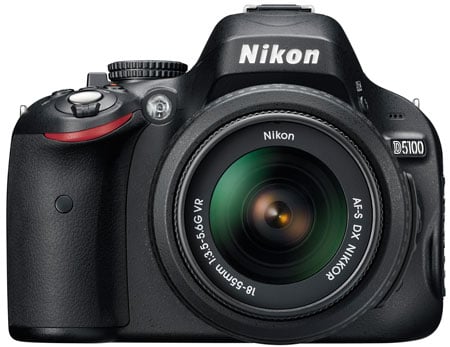Nikon D5100
-
-
Written by Gordon Laing
Intro
The Nikon D5100 is the company’s latest ‘upper-entry-level’ DSLR aimed at beginners or those wanting a step-up from a basic budget model. Announced in April 2011, it comes exactly two years after its predecessor, the popular D5000. The new D5100 is positioned between the entry-level D3100 and the mid-range D7000, and goes head-to-head against Canon’s EOS 600D / Rebel T3i.
Externally the Nikon D5100 enjoys a redesigned shape that’s noticeably shorter than its predecessor and a little lighter too. Physically the biggest difference though concerns the screen round the back: it’s still articulated, but taking a leaf from Canon and Panasonic, it’s now hinged at the side rather than the bottom. Nikon’s also upgraded the screen from the basic 2.7in / 230k panel of the D5000 to a larger and much more detailed 3in / 921k panel here.
Inside, the D5100 inherits the 16.2 Megapixel sensor of the D7000, giving it four Megapixels more than its predecessor. It also unsurprisingly now offers Full HD 1080p movie recording, although unlike the D7000 this is offered at 24, 25 or 30fps. The D5100 also offers the Full-time continuous autofocus during movies of the D3100 and D7000 before it, along with an external microphone input. Completing the headline upgrades is a new EFFECTS position on the dial which presents a variety of special effects including miniature, sketch and selective colour, along with a Night Vision option working at up to 102,400 ISO. Let’s now look at the camera in more detail.
|  |
So the Nikon D5100 essentially offers three major upgrades over its predecessor: it inherits the excellent sensor of the D7000, upgrades the screen size, resolution and hinge mounting, and borrows the core movie capabilities of the D3100 and D7000, while also offering a broader selection of frame rates at 1080p and a mic input. The much preferable side-hinging for the screen has also eliminated the D5000’s disproportionately tall viewfinder head, allowing Nikon to design a shorter and curvier body for the new model. In addition to this you also get the new EFFECTS mode which can be applied to some movies as well as stills, along with an HDR option.
While the viewfinder, AF system and continuous shooting remain essentially unchanged from its predecessor, the upgrades described above add up to a much improved camera experience. Revealingly most of the core improvements are focused around the Live View and movie modes, with little other than an improved sensor to tempt traditional photographers, but that’s par for the course for most new entry-level DSLRs. Canon employs exactly the same strategy, essentially leaving Sony to innovate at this price point.
If you were hoping for faster continuous shooting, improved AF or a bigger viewfinder, you’ll be disappointed, but by offering the D7000’s quality at a lower price point with an excellent flip-out screen and a broader selection of 1080p frame rates, there’s a great deal to like here. The D5100 is destined to become another big seller for Nikon, although its rival from Canon has never been closer.
In my full review of the Nikon D5100 I’ll not only describe and test all of its features in-depth, but also take a close look at how the Canon EOS 600D / Rebel T3i compares in every respect. If you’re in the market for an upper entry-level DSLR and don’t already have an existing investment in lenses, both models will probably be top of your shopping list. I’ll point out the pros and cons of each and by the end of this review, you’ll know which one will be best for you. In my verdict you’ll also find a detailed comparison against the two models on either side of the D5100 in Nikon’s range, to find out whether it’s worth spending more, or indeed saving some money.
Testing notes
I tested a final production Nikon D5100 running Firmware versions A 1.00, B 1.00 and L 1.003. Following our convention of using default factory and best quality settings to test cameras unless otherwise stated, the D5100 was set to its best quality Large Fine JPEG mode with Auto White Balance and the default Standard Picture Control, with Noise Reduction and Active D-Lighting both enabled at their default settings; note Active D-Lighting was disabled for our High ISO Noise tests as it can introduce noise.




